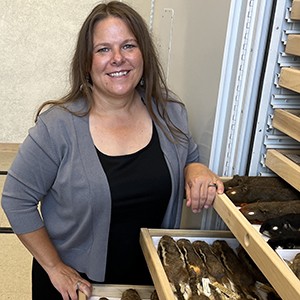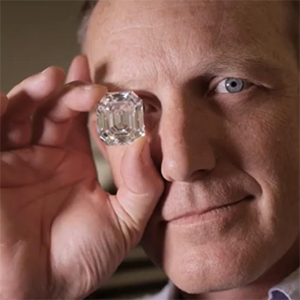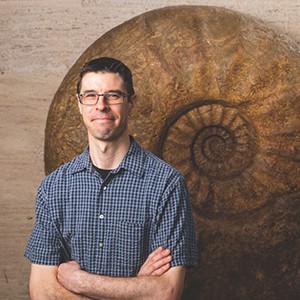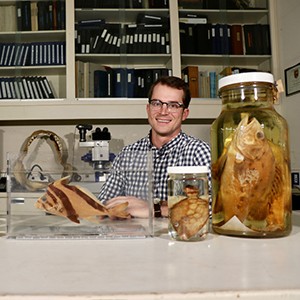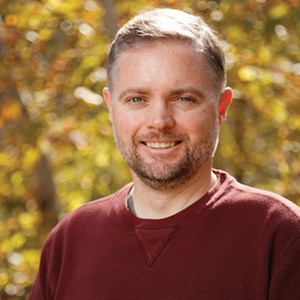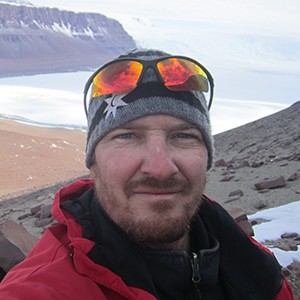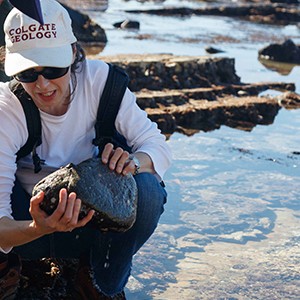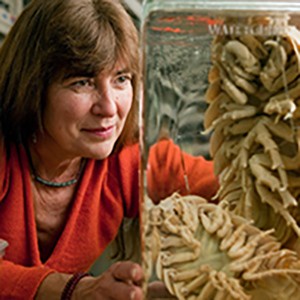NHMLAC Mentors & Research Projects
Kayce Bell
Assistant Curator, Terrestrial Mammals
Research Area: I oversee the terrestrial mammalogy collection and focus my research on small mammal diversity and parasites.
Previous UNLAB Research Project: An UNLAB researcher worked with me to study the distribution of California ground squirrels in Southern California and determine what landscape characteristics allow them to persist in a region heavily impacted by humans. We used natural history collection specimen records and iNaturalist observations to model the factors that may impact ground squirrels now and in the past.
Favorite thing about being a researcher: I love my research because there is so much left to discover, even in groups that are relatively well-studied, such as mammals. In particular, I enjoy learning how species interact with their surroundings and other species and how those interactions shape their evolution and diversity.
Aaron Celestian
Curator, Mineral Sciences
Research Area: I am researching how minerals interact with their environments and with living things, and how those minerals can be used to solve problems like climate change, pollution, and disease.
Favorite thing about being a researcher: I find great pleasure in learning about new topics and discovering the fascinating ways in which biology and mineralogy intersect. Although science can be challenging, the moments of discovery and invention are truly gratifying and motivate me to delve further into the subject.
Austin Hendy
Assistant Curator, Invertebrate Paleontology
Research Area: I oversee the invertebrate paleontology collections and focus my research on marine biogeography, paleoecology, and paleo-environments preserved in Earth's recent geological record.
Previous UNLAB Research Project: An UNLAB researcher worked with Kelvin Barwick (co-mentor) and I to map out the physical characteristics of rocky intertidal habitats and their biodiversity along the Palos Verdes Peninsula coastline of Los Angeles. The project involved both geospatial information systems (GIS) and observational surveys to document spatial variations in species distribution and community composition, and establish the impact of human interactions and conservation efforts in this area.
Favorite thing about being a researcher: I love my research because it enables discovery and understanding of the world around us, and my work allows me to document the past and present and postulate on the future of our changing planet and biodiversity. I consider myself to be a time traveling marine biologist, using our valuable museum collections and new field discoveries to travel back in time to reconstruct past environments and species interactions, and add to the scientific knowledge of evolution and earth systems.
Bill Ludt
Assistant Curator, Ichthyology
Research Area: I oversee the ichthyology collection and focus my research primarily on understanding how the Earth's fishes are related to one another and determining what factors have influenced where fishes occur and how that has changed over time.
Previous UNLAB Research Project: An UNLAB researcher worked with me to examine micro-plastic consumption across time in a local species along the California coast. This project involved determining how many micro-plastic particles were in the stomachs of museum specimens, but also determining what types of plastics they were.
Favorite thing about being a researcher: My favorite part about doing research is learning more about life on our planet. Fishes can be difficult to observe in the wild, and each discovery we make about them and how they evolved can feel like solving an unsolved mystery.
Greg Pauly
Curator, Herpetology
Research Area: I oversee the herpetology collection and focus my research on the conservation, ecology, and evolution of reptiles and amphibians, with much of my work examining impacts of urbanization.
Previous UNLAB Research Project: In 2023–2024, an UNLAB researcher worked with me to examine whether snakes are exposed to anticoagulant rodenticides and to assess whether exposure rates changed following a January 2021 statewide ban on residential use of some rodenticides. This project involved working with community scientists to acquire specimens, specimen dissection, and statistical and geospatial analyses.
Favorite thing about being a researcher: My favorite part about research is making new discoveries, whether those be through field or lab work; I love that we get to identify questions of interest to us, design studies to answer those questions, and then learn new information. I also take a great deal of pride in not only building scientific knowledge through publishing research but in building the natural history collections that will determine the scientific questions future researchers will be able to answer.
Allison Shultz
Associate Curator, Ornithology
Research Area: I oversee the ornithology (birds) collection and focus my research on feather evolution and evolution in urban environments.
Previous UNLAB Research Project: The 2023–2024 UNLAB researcher worked with me to analyze the presence of black carbon on bird feathers over the last century in southern California to better understand patterns of air pollution through time in this area before historical records were collected. This project involved photographing specimens at NHMLAC and other California museums, using the Scanning Electron Microscope, analyzing photographs, and conducting statistical analyses over time.
Favorite thing about being a researcher: I love that in my job I get to ask the questions that I'm curious about and be the one to discover the answers to those questions. I love both observing nature in the field, as well as applying exciting new technologies to specimens that were collected over a century ago to understand nature and biodiversity in a way we couldn't before.
Nathan Smith
Curator, Dinosaur Institute
Research Area: I oversee the dinosaur and Mesozoic vertebrate collection and focus my research on early dinosaur evolution and diversification.
Previous UNLAB Research Project: An UNLAB researcher worked with me to assess anatomical biases and evolutionary signal in the bird fossil record. Their project involved working with multiple museum databases and records, as well as ground truthing database data with physical reviews of collections.
Favorite thing about being a researcher: My favorite part of my job is probably fieldwork and discovering and collecting new fossils from amazing places around the world. I also enjoy that paleontology is such an interdisciplinary science that allows us to bring together a diverse toolkit of skills and methods to answer questions about Earth's history.
Jann Vendetti
Associate Curator, Malacology
Research Area: I oversee the malacology (mollusk) collection and focus my research on the morphology and genetics of native and introduced snails in Southern California.
Previous UNLAB Research Project: In 2023–2024, an UNLAB researcher and I investigated the identity, distribution, and genetics from a European snail that is established widely throughout Southern California. This project included field work, specimen dissection, photography, the Scanning Electron Microscope, the use of iNaturalist, and molecular work.
Favorite thing about being a researcher: My favorite thing about research is that I get to use a variety of techniques to ask and answer questions about native and non-native mollusk species. I also enjoy exploring, learning about, and collecting snails from across Southern California, in urban environments, the marine intertidal, Mojave desert, and Verdugo and San Gabriel Mountains.
Jorge Velez-Juarbe
Associate Curator, Marine Mammals
Research Area: I oversee the collections of modern and fossil marine mammals and my research focuses on the evolutionary history of sirenians, pinnipeds and cetaceans, and the origins of terrestrial and marine vertebrates from the Caribbean region.
Favorite thing about being a researcher: One of the favorite parts of my job is fieldwork, which has allowed me to travel to multiple localities across the Americas and the Caribbean to discover the fossilized remains of new and exciting extinct species. My other favorite aspect is studying fossils in great detail to figure out and disentangle their relationships, evolutionary history and the role they played in the ancient environments they lived.
Regina Wetzer
Curator and Director, Marine Biodiversity Center
Research Area: I oversee the Marine Biodiversity Center and focus my research on the biodiversity of invertebrates and how species are related to one another.
Favorite thing about being a researcher: I love that my job involves fieldwork in diverse habitats all over the world, that I have the most amazing colleagues around the world, and that I get to mentor students as passionate as myself while learning about our natural world. I am especially fond of a group of marine pill bugs in the family Sphaeromatidae, which I assert are as cute as buttons.
